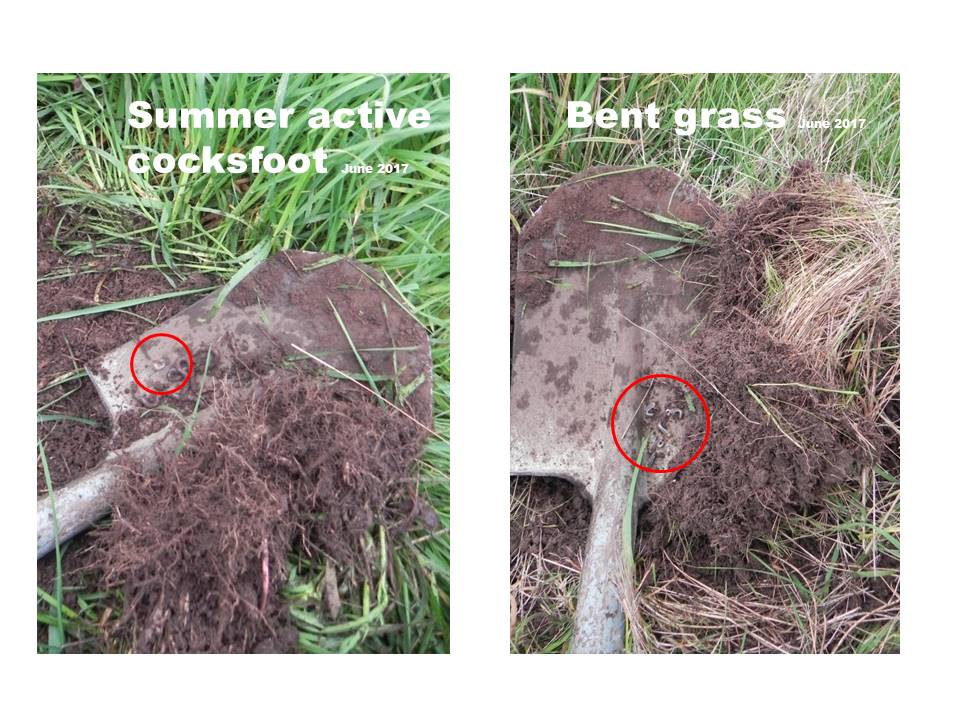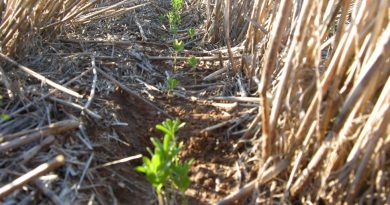Yellowheaded pasture cockchafers – ally or enemy?
By Patrick Francis
The Yellowheaded cockchafer larvae are a common soil inhabitant on Moffitts Farm. During autumn and winter we find it in virtually every spade full of soil and treat it as part of the soil food web. The black headed cockchafer has not been seen.
Figure 1: Yellowheaded cockchafer (Sericesthis harti) is the main species of white curl grub affecting pastures and cereal crops across south-eastern Australia. Photo: Patrick Francis.
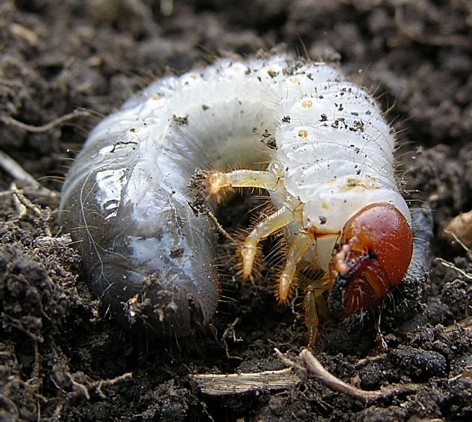
My observations of the Yellowheaded cockchafer larvae over many years are they are probably more beneficial than negative for soil and pasture health.
Their negative publicity comes from chewing through the close to surface roots of cereal and pasture plants. If large numbers are present this can lead to areas of dead plants – severed roots just below the surface. The severing can be so extensive that the pasture mat can be rolled or pushed off the surface – figure 2.
Figure 2: In April 2008 Yellowheaded pasture cockchafer larvae were so numerous in bent grass dominant patches of pasture that the herbage mat could be rolled off the surface. Photo: Patrick Francis.
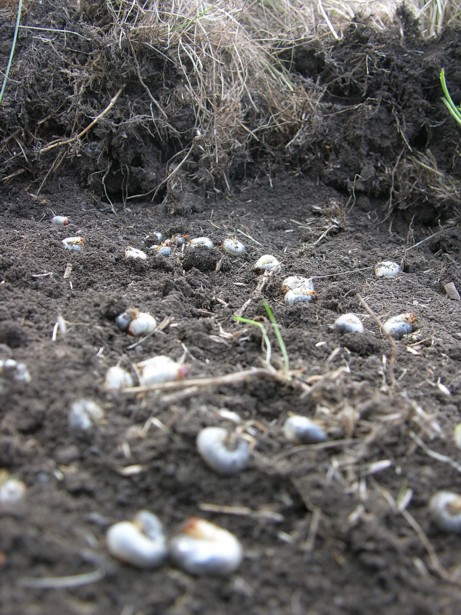
There are a number of reasons why I don’t see this as a problem if pasture and grazing management strategies are adopted to accommodate these cockchafers as part of the soil food web:
- Yellowheaded cockchafers add to pasture biodiversity and encourage birds into paddocks (I suspect ibis are particularly adept at finding them, figure 3).
Figure 3: Sacred or White ibis are likely to be attracted to paddocks where some Yellowheaded pasture cockchafer larvae are present. Photo: Patrick Francis.
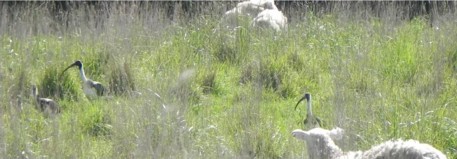
- They seem to have exceptional ability to “till” and aerate the soil. Where they are thick and the surface herbage mat is lifted, the soil is light, fluffy and smells magnificent, figure 4.
Figure 4: When Yellowheaded cockchafer larvae are numerous in “thin” root and stem grass pastures their activity can give the soil surface a magnificent tilth. Photo: Patrick Francis.
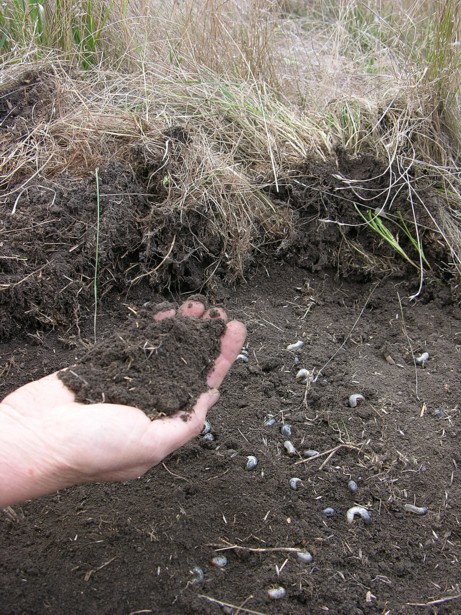
- Their population dynamic is cyclical. I suspect a combination of below average summer and autumn rain plus warm temperatures plus herbage density and cover impact population. I have seen just one major outbreak event since 2000, that was in April 2008 (rainfall for the first four months was around 60% below average).
- They seem to favour what I describe as thin, short rooted grass species, like bent grass, sweet vernal, silver grass etc. They don’t seem to attack the vigorous, thick stem and root species like tall fescue, cocksfoot and phalaris, figure 5.
Figure 5: The thin stemmed bent grass roots have been severed just below the surface killing the leaves, but the thick stemmed tall fescue is not affected and continues to produce green leaves. Photo: Patrick Francis.

My approach is to accept the Yellowheaded cockchafer as part of the soil food web and manage pasture species to avoid any issues with it. I could imagine that some farmers who have dominant bent grass/annual grass pastures could occasionally have a severe autumn/winter feed shortage as a result of Yellowheaded cockchafer activity. But relying on bent grass and annual grasses for winter feed is a risky anyway because they have such poor cool season growth. If the farm stocking rate exceeds farm carrying capacity during the period, supplementary feeding will be needed whether or not cockchafers are present.
During the spring after the cockchafer damage, the bent grass pasture grows again and by late spring early summer the insect larvae impact is likely to have disappeared.
To avoid the damage in the first place, my approach is to plant a complex pasture comprising the vigorous thick stemmed, crown forming species like cocksfoot, tall fescue, phalaris, brome grass (I would classify perennial ryegrasses as thin stemmed and susceptible to cockchafer damage). Then manage these pastures with rotational grazing to retain a minimum of 1200 kg/hectare of green dry matter herbage when livestock exit the paddock. Allow the grasses to recover after grazing to thicken roots and crowns and achieve a minimum of 2000 kg green dry matter per hectare – 3000 kg plus is even better.
With this sort of management, paddocks will retain and improve ecosystem functions like water infiltration rather than runoff, manure return into the soil, and increased above and below surface biodiversity. At the same time the Yellowheaded cockchafer becomes a contributor to the pasture ecosystem rather than a negative.
Some advisors suggest minimising pasture cover (below 1000 kg/ha of herbage) in summer and autumn as a method of controlling Yellowheaded cockchafers. The thinking being this exposes the eggs (laid in summer) and larvae (emerge in autumn) to predators and creates a soil environment less favourable for their survival.
That is a strategy which might lower the cockchafers’ population but has negative impacts on paddock ecosystem functions, paddock feed for livestock, pasture plant resilience and livestock worm larvae.
Take home message
Vigorous pastures species managed for resilience to variable rainfall will be able to accommodate a range of insects such as Yellowheaded cockchafer larvae, field crickets and red legged earth mites. They become part of the soil food web rather than a problem.
2017 Update
Autumn 2017 produced exceptionally good pasture growth on Moffitts Farm due to April rainfall approximately 250% above average. In early June I dug some “spade” soil samples to check for Yellowheaded cockchafer larvae population. As figure 6 shows, their number was low (1 per spade) in rested Porto cocksfoot dominant pasture (greater than 3000kg/ha green dry matter) compared with 9 per spade in patches of bent grass in the same paddock (approximately 1500kg/ha green and dead dry matter).
What stands out to me in figure 5 is the difference in the root density and thickness of the cocksfoot compared with the bent grass. My anecdotal evidence suggest the larvae are less numerous in the cocksfoot dominant soil compared with the bent grass dominant soil and this has something to do with the density and thickness of the cocksfoot roots.
It is interesting that in June 2017 the Yellowheaded cockchafer larvae present are much smaller than what they were in the April 2008 episode when they completely severed the bent grass roots below the surface and enabled the dead grass to be rolled off the surface. In June 2017 the bent grass is being damaged but not as badly as in 2008.
Figure 6: A quick soil survey in June 2017 demonstrates how the Yellowheaded cockchafer larvae are rare in a cocksfoot dominant pasture, but are prolific in a nearby patch of bent grass. Photos: Patrick Francis.
